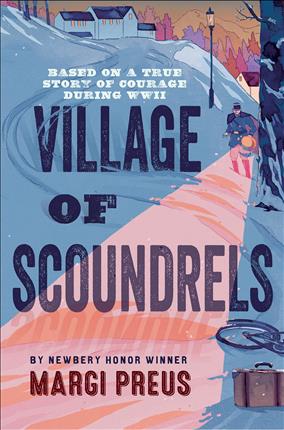| Village of scoundrels Author: Preus, Margi | ||
| Price: $6.50 | ||
Summary:
In the 1940s, remote Les Lauzes, France, houses Jews, unregistered foreigners, forgers, and others who take great risks to shelter refugees and smuggle them to safety in Switzerland.![]() Download a Teacher's Guide
Download a Teacher's Guide
| Accelerated Reader Information: Interest Level: MG Reading Level: 5.80 Points: 9.0 Quiz: 506785 |
Reviews:
Kirkus Reviews (+) (11/01/19)
School Library Journal (01/01/20)
Booklist (12/01/19)
The Bulletin of the Center for Children's Books (00/01/20)
The Hornbook (00/03/20)
Full Text Reviews:
Booklist - 12/01/2019 Preus’ latest, being about a community of equally interesting characters, lacks a central hero or heroine, yet the many parts nevertheless make for a fascinating whole of historical facts about the real-life village of Le Chambon (here fictionalized as Les Lauzes) and how it managed to save an amazing number of Jews from the Nazis in WWII France. Inspector Perdant, eager to catch the titular “scoundrels” opposing the Germans, ties together the narratives of a group of children and teens who risk their lives by forging documents, supplying the French Underground, and escorting the endangered to the Swiss border. The stories all come together on a memorable night when Jules, the youngest rebel, leads Perdant on a wild goose chase in order to keep safe the others, who have met up with a band of partisans at a deserted château. An epilogue covers the nonfictional stories of those who inspired Preus’ characters. Readers inspired by communities making a difference—and in WWII and Holocaust history—will find much of interest here. - Copyright 2019 Booklist.
School Library Journal - 01/01/2020 Gr 5–8—During World War II, several remote villages in Southern France were home to a community of resistance fighters. Farmers, educators, and clergy all played a part, but this story highlights the daring work of young men and women who forged documents, moved supplies and passed along coded information. For example, one teen created documents that secured his mother's release from an internment camp. One young woman bicycled for miles to deliver messages and contraband. Some used their Boy Scout training in outdoor survival to spirit refugees, sometimes disguised as troop members, to safe houses or through the arduous journey out of France and into Switzerland. This fascinating story is inspired by actual people and events. It highlights an interesting piece of history but is weakened by the narrative structure. It bounces around various plotlines, robbing each one of the tension that starts to build and causing the story to lose momentum. Extensive back matter helps compensate with information about the people, places, and missions that form the novel's basis, as well as a comprehensive bibliography including books, documentaries, and links to museum exhibits. There is also a pronunciation guide to the names of the French characters and locations. VERDICT Overall, this book does a decent job of honoring these young people who stood up and made a difference. An additional historical fiction purchase for libraries serving middle graders.—Carla Riemer, Albany High School, CA - Copyright 2020 Publishers Weekly, Library Journal and/or School Library Journal used with permission.



